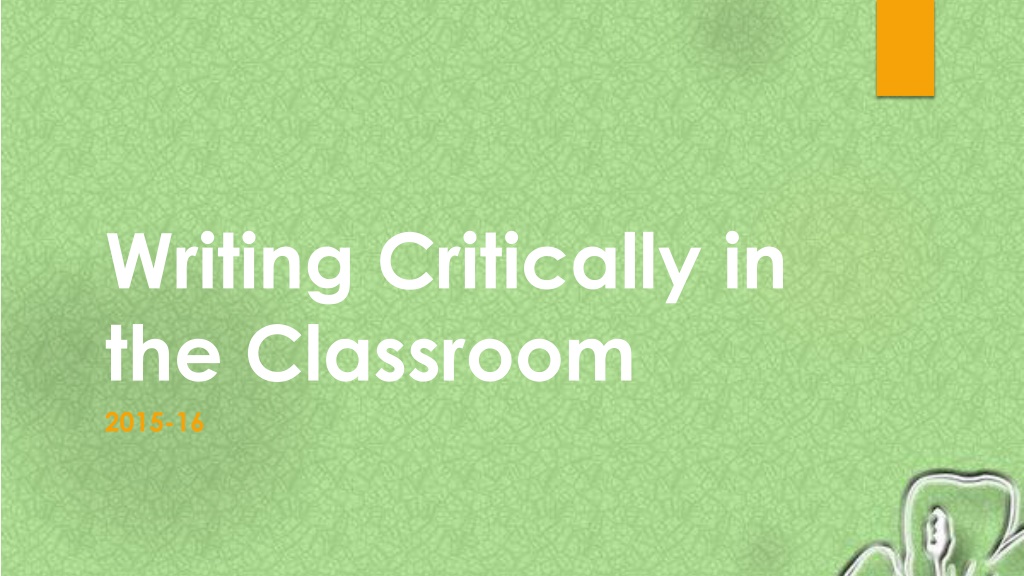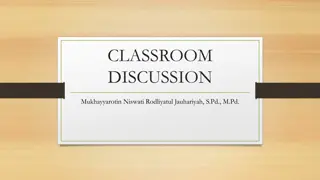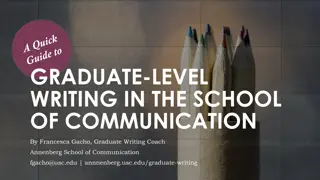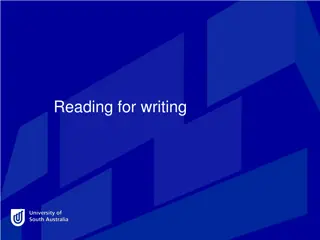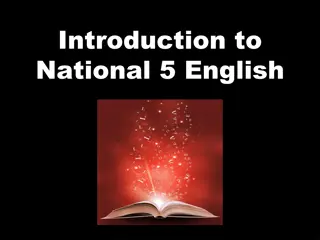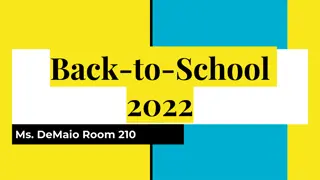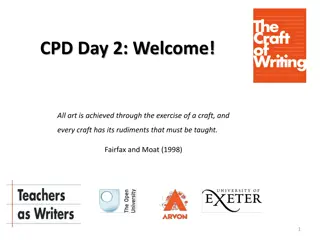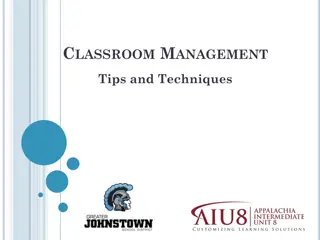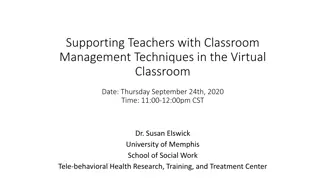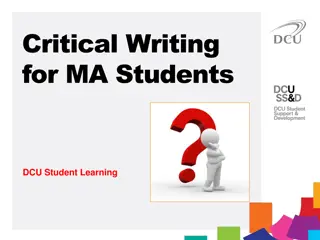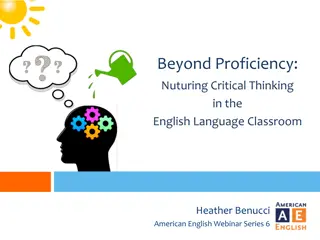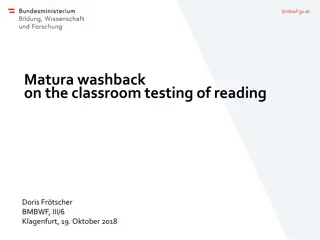Understanding Critical Writing in the Classroom
Critical writing involves organizing, analyzing, and expanding on ideas, requiring learners to bring subconscious thoughts to a conscious level through writing. Stem sentences help in questioning different levels of understanding, and strategies like SiMPlE Subject aid in reflecting on passages.
Download Presentation

Please find below an Image/Link to download the presentation.
The content on the website is provided AS IS for your information and personal use only. It may not be sold, licensed, or shared on other websites without obtaining consent from the author. Download presentation by click this link. If you encounter any issues during the download, it is possible that the publisher has removed the file from their server.
E N D
Presentation Transcript
Writing Critically in the Classroom 2015-16
What is Critical Writing? Writing for the purpose of organizing, clarifying, defending, refuting, analyzing, dissecting, connecting, and/or expanding on ideas or concepts. (Cain and Laird, 81)
What does Critical Writing Require of the Learner? The learner takes a subconscious idea, expand on that idea, connect it to other subconscious ideas, and bring that to the conscious level through the tangible act of writing. Idea + expansion of idea + connections to other ideas = conscious level through writing (Cain and Laird, 82)
Stem Sentences Level 1 Questioning: What information is given? Locate in the excerpt/article/story where When did the event take place? Point to the List the Name the Where did ? What event led to ? What is ? Who was/were ?
Stem Sentences for Level 2 Questioning: What would happen to you if ? Would you have done the same thing as ? What occurs when ? Compare and contrast ____ to ______. What other ways could _____ be interpreted? What is the main idea of the story (event)? What information supports your explanation? What was the message in this piece (event)? Give me an example of ____? Describe in your own words what ____means? What does ______suggest about _______ s character? What lines of the poem express the poet s feelings about ____________? What is the author trying to prove? What evidence does he present?
Stem Sentences Levels 3 Questioning: Predict what will happen to ____as ____ is changed. Write a brief new ending to the story (event) Describe the events that might occur if . Add something new on your own that was not in the story. Pretend you are What would the world be like if ? Change the point of view of the article. How would it be different? Would it change? What do you think will happen to ____? Why? What is most compelling to you in this _____? Why? Could this story have really happened? Why or why not? If you were there would you ? How would you solve this problem in your life?
Strategies: Reflecting on the Passage: SiMPlE Subject: What does the author/writer do? Meaning: What does it mean? Purpose: Why does the author do this? Effect: How does it contribute to meaning? English Student Example The author uses pronouns (without an antecedent) throughout the beginning of novel to refer to a crime he has not committed. Character cannot even name his planned crime to himself; knows it is wrong and so acts as if he would not do it Reinforces the forbidden, taboo aspect of the action; wants to show his elitist attitude toward the crime and those that would commit such an act. (analysis)
Reporters Notes Reporter s notes help you get the crucial information- not just the facts, but the meaning of the facts. These are the questions reports ask when they write their articles. These are the questions good readers ask. Not all questions are always appropriate-if left blank, explain why you left it blank. WHO (is involved or affected) WHAT (happened) WHERE (did it happen) WHEN (did it happen) HOW (did they do it or did others respond) WHY (did they do this, react this way) SO WHAT? (Why is this event/info/idea important?)
stem questions Interactive Notes helps students read information or literary texts and guides them through the reading/instructional process. BEFORE Prepare to Read: List titles, headings, captions, objectives, themes, words to know; ask questions, make predictions, set a purpose, decide what matters most DURING Question and Comment: I wonder why This is important because What do they mean by What will happen next is As I read, I keep wanting to ask What caused I think What I find confusing is This reminds me of I can relate to this because AFTER Summarize and Synthesize Three important points/ideas are What comes next At this point the article/story is about The author s purpose is to I still don t understand A good word to describe ______ is____ because This idea/story is similar to These are important because The author wants us to think What interested me most was
Four Core Questions Association: What/who goes with what? Opposition: What opposes/resists what? CONCEPT/IDEA ______________ Progression: What follows what? Transformation: What changes into what?
Four Core Questions Student Example (uses listing and complete sentences to answer questions) Concept: Transcendentalism Association: What/who goes with what? Authors-RW Emerson; Thoreau; Writings-Walden Pond, Self- Reliance; Characteristics-were inspired by the beauty of nature; emphasized emotions and the imagination over reason; celebrated the individual spirit Opposition: What opposes/resists what? Transcendental thinkers opposed reason and the strict doctrines of Puritanism of the previous time period. Progression: What follows what? Romantic Period followed Transformation: What changes into what? Romanticism reflected more modern sensibilities and celebrated the glories of the individual spirit and qualities all people share.
Making a Connection PERSONAL CONNECTIONS TEXT/INDIVIDUAL CONNECTIONS WORLD CONNECTIONS Personal Connection I can associate with this . This ______reminds me of This ____reminds me of After making connections, I understand the story/concept better because_______________________________.
Making Inferences Organizer What the Text Says: What I Already Know: What I Infer (about the characters, event, or situation):
The Exit Ticket The exit ticket is used after the learning objective is taught. Examples: Spanish Class: translation of written Spanish sentences to written English (application ) English Class: summarize a plot, character, writing procedure, etc. (summarization)
Exit Ticket continued. Exit tickets also provide insight to what students don t understand: Examples: Math: What part of the equation (or story, procedure, problem) don t you understand? History: After reading MLK s speech, write down a question (or two) about what you don t fully comprehend.
Journaling (great bell ringer) Bell Ringers get the conversation started or continue the conversation from the day before. Prior knowledge: History example: In three minutes, write down events/people/ideas associated with the Civil Rights Movement. (connections) English: List four writing tools that can be used in a descriptive paragraph (listing) Math: Write down the step-by-step process in _________ (clarifying) Economics: How could you use Dave Ramsey s financial tip of ___________ in your own life? (application)
Word Banks to Help Summarize History: Explain the 1920 s, using the words in the word bank. Math: Formulate a word problem for __________ (concept), using the words in the word bank. Summarize the steps to solve the problem, using the word bank. English: Using the word bank, create a 200 word short story. Science: Using the word bank, describe the life cycle of a frog.
Literary/Summary 3x3 Works best with text that has a beginning, middle, and end (fiction, movies, biographies). Create three, three-word sentences that summarizes an intended text to be sure students understand the story/article. Student Example: from media analysis class of the movie The Help: LITERAL SUMMARY (summary) Women write book. Race conflicts escalate. Book creates commotion. REFLECTIVE SUMMARY (analysis/summary) Racism runs rampant. Voices come together. Injustices reveal truth.
Comparisons/Contrasts Students write on both sides of an index card for a comparison/contrast reflection Examples: Art class: Front: Compare Vincent Van Gogh s painting _____ with his earlier work entitled _____________. Back: Contrast the two paintings.
Contrasting Opinions Contrasting opinions allow students to analyze various perspectives. Materials Used: index cards; sticky notes; card stock History example: After reading a piece on British Imperialism, identify the perspective of the British citizens of that time period. Back side: Identify the perspective of the citizens living in India during the British expansion into their country.
Two-sided Notes Fold a paper in half. On the top left side, write down text evidence (literal information). On the top right side, write down inference. This could also be done on an index card. Example: Character/individual analysis After reading a portion of a text/article, students write down the major actions demonstrated by the individual/character (left side). On the right side, students write down a possible motive/intent (that goes along with the text/article).
A.P.E. APE is a simple way in which to write a short answer response. A- answer a specific question P- prove with text evidence E- explain how evidence connects to answer
One (or two or three) Minute Response Students answer a focused question (use stem questions) with a specific goal that can be answered within a minute or two. Examples: English: After small group purposeful talk, students list the differences between the Puritan community in The Crucible and John Edward s Puritan community. Art: Generate a descriptive list of the painting entitled ___________. History: After discussing historic leaders and leaders in their own lives, students list the qualities of a strong leader.
Believing, Doubting, and Transforming Directions: After reading an article, respond to the questions in each section of the three- column chart below. Believing Doubting Transforming Which claims could be changed or modified to better represent how you think? Which claims (assertions), if any, do you believe? Which claims, if any, do you doubt? Quickwrite: What is your position overall?
Critical Writing in the Math Classroom During Instruction: Students can use individual dry erase boards in conjunction with math problems so the roaming teacher can quickly check for understanding. Before/After Instruction: Teacher posts critical thinking question on the board. Students use small group discussion to obtain possible answer. Student writes down answer in sentence format. Bell Ringer: Pose a question from the previous day s lesson; students use first five minutes to journal answers/responses. Journals collected at the discretion of the teacher. Post a survey question about the hardest concept associated with a lesson. Writing in complete sentence(s), the student explains the difficulty encountered with the concept.
Revising in 30 Seconds After writing critically, students should: Check for opening capitalization and end marks when writing complete sentences. Check for capitalization of proper nouns specific names and places in listing, phrases, sentences. Eliminate "text message jargon/spelling/symbols (@, i, w/, 2 ; cuz ) from all academic writing. Write legibly and clearly.
Its a Great Day to Be a Zebra! The end .
